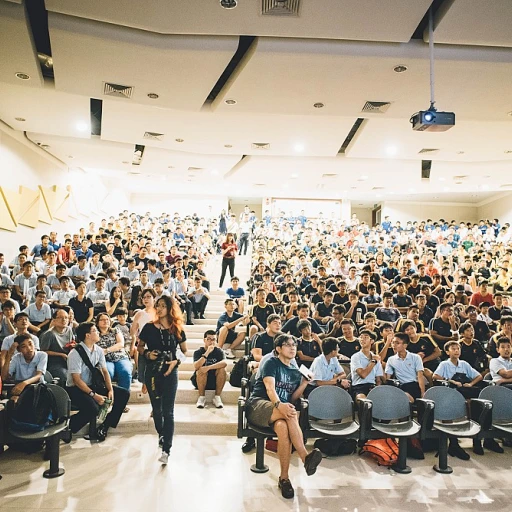Defining the Whirlwind at Work
Unveiling the Workplace Whirlwind
In the dynamic world of business, keeping pace with the multitude of tasks, goals, and changes can often feel like being caught in a whirlwind at work. The whirlwind is characterized by the daily hustle and bustle that tends to overshadow strategic plans and long-term goals. Companies strive to maintain a balance between their day-to-day operations and strategic disciplines essential for growth. However, the day-to-day operations, or the 'whirlwind' of business, primarily focus on immediate and urgent tasks that require constant attention. The irony is that while these tasks are crucial, they often overshadow more strategic goals and planning. Leaders and team members frequently find themselves tangled in this whirlwind, impacting their ability to focus on strategic initiatives. This whirlwind not only affects individuals but also hinders the execution of key business goals, creating a barrier between where a company is and where it aims to be. Understanding the whirlwind's impact on your work environment is crucial. It involves recognizing how much time spent on reactive tasks can detract from proactive goal setting. By examining how your team's cadence of accountability is managed, businesses can better navigate the whirlwind, aligning time work with strategic objectives. Strategic planning requires both discipline and execution. Embarking on strategic goal setting demands clear systems, focused leadership, and an aligned team working towards wildly important goals. To dive deeper into managing these challenges, organizations must first understand the whirlwind's nature. Addressing this is key to fostering business growth and enhancing employee engagement. Learn more about actionable strategies in HR communication by exploring the ins and outs of employee feedback on HR communication initiatives.Identifying the Causes of Workplace Whirlwind
Unveiling the Origins of Workplace Chaos
To effectively address the whirlwind at work, it's crucial to understand the underlying factors contributing to this chaos. The modern work environment is characterized by rapid change and evolving demands, which can make maintaining focus challenging. Below are some key aspects that often lead to the whirlwind in organizations:- Leadership Challenges: Leadership plays a pivotal role in setting the tone for strategic discipline within an organization. A lack of clear direction or inconsistent communication from leadership can lead to confusion among team members, hindering goal execution.
- Misalignment with Strategic Goals: When employees don't understand how their day-to-day tasks align with broader business goals, the risk of losing sight of wildly goals increases. This often results from inadequate strategic planning and a poor positioning system.
- Lack of Systems and Processes: Companies that do not establish strong systems for accountability and decision making often face disruption. An absence of structured disciplines execution and cadence accountability can incite a lack of focus among teams.
- Overwhelming Time-Pressures: The whirlwind is exacerbated by the pressures of time. When employees are consumed by their day job responsibilities without considering strategic initiatives, work life balance suffers, and business growth stalls.
- Communication Barriers: Inconsistent or unclear communication leads to uncertainty and confusion across teams, making it harder for them to execute their strategic plans. This can dampen employee engagement and hinder long-term productivity.
The Impact of Whirlwind on Employee Engagement
The Toll of Chaotic Momentum: Influencing Employee Engagement
Navigating through the whirlwind of chaos in the workplace isn't just about surviving day to day. Its impact stretches far beyond our schedules and directly influences employee engagement. When the workplace whirlwind spins out of control, it can erode the core of business productivity and morale.
Employee engagement, a crucial component for business growth, often suffers when employees find themselves overwhelmed by the chaos surrounding them. The whirlwind can lead to inefficiencies in time management, leaving team members distracted and unable to focus on achieving wildly important goals. This can be especially true when there's a lack of strategic discipline, leading to an imbalance between day-to-day job tasks and strategic planning.
With a frenetic work environment, employees may spend more time reacting to immediate issues instead of working towards long-term company goals. This not only diminishes their ability to execute strategic plans effectively but also undermines the overall objective of achieving business growth. Such behavior impacts their motivation, leading to decreased employee engagement and ultimately affecting the organization's success. See how understood salaries can form part of this engagement picture.
The lack of a strategic focus within a working whirlwind makes it hard for employees to practice strategic discipline and align with the company's objectives. When leadership fails to position effective systems to manage the whirlwind, it becomes difficult for employees to maintain cadence accountability and improved execution.
Ultimately, the impact of this disarray translates into hindered business growth with potentially significant repercussions on team cohesion and the company culture. Employees need stability, strategic direction, and clear goals to foster a productive work life. It is essential for leadership to implement systems and disciplines that minimize chaos, paving the way for a more engaged workforce striving toward the organization's long-term objectives efficiently.
Strategies for Managing the Whirlwind
Implementation of Structured Systems
In the realm of managing workplace chaos, establishing structured systems is paramount. These systems help in providing a consistent framework for activities and ensure that the whirlwind of daily operations doesn’t overshadow the strategic goals of the business. By employing a strategic discipline, companies can position systems that support a more stable work environment.
Clear Goal Setting
One critical aspect of taming the whirlwind at work is clear goal setting. Leadership needs to ensure that both short-term and long-term objectives are well-communicated to all team members. This enables individuals to focus on wildly important goals (WIGs) amidst daily disruptions, ensuring people remain aligned with the company’s vision.
Regular Cadence of Accountability
Cadence accountability is another strategy that ensures teams are not just busy but effectively working towards their goals. Through regular check-ins and reviews, businesses can assess the time spent on various tasks. This proactive approach allows leadership to identify what is going well and what needs change, all while maintaining employee engagement.
Focus on Strategic Execution
Strategic execution is essential for driving business growth. By honing in on what is truly important, businesses can mitigate the chaos of day-to-day operations. Leaders should incorporate strategic planning sessions that help in refining execution plans, thus fostering an environment where decision making is informed and efficient.
Role of Technology in Mitigating Workplace Chaos
Leveraging Technology to Streamline Operations
In an ever-changing work environment, technology stands as a beacon of support for businesses seeking to mitigate the whirlwind effect. Effective utilization of digital tools can position systems in a way that not only increases efficiency but also enhances transparency and communication within teams. The strategic discipline of employing such tools can bring about a remarkable change in how teams execute their day-to-day operations. One of the critical advantages technology offers is the ability to focus efforts on strategic goals without getting overwhelmed by routine tasks. Time spent on repetitive activities can be cut down significantly through the use of automation tools. This dedication of time to more strategic planning and decision making allows leadership and team members to align more closely with the company's long-term goals. Moreover, positioning systems that leverage technology can enhance business growth by ensuring that strategic plans are communicated effectively across the board. By creating a cadence of accountability, technology aids in keeping the team on track, ensuring that wildly important goals are pursued amidst the chaos of the working day. In addition, robust privacy policies ensure that all digital communications within the company are secure, which further establishes trust and improves employee engagement. When people feel secure and informed, they are more likely to engage meaningfully toward strategic execution. As businesses continue to evolve, the role of technology in managing the whirlwind will only grow in importance. It is not just about keeping pace with what is going on but also about leading change with strategic intent and focus. Therefore, savvy companies embrace these tools as part of their core business strategies, adapting to changes and enhancing discipline execution in pursuit of their objectives.Building a Resilient Communication Framework
Strengthening Communication Channels
Understanding the whirlwind in the workplace is crucial for developing a resilient communication framework that can withstand daily challenges. A robust system prevents the whirlwind from amplifying chaos and miscommunication. Business leaders need to focus on strategic planning to ensure that communication remains clear and consistent, even amidst day-to-day distractions. Creating a resilient communication framework involves several key elements:- Clear and Defined Channels: Establishing clear communication channels helps team members know where and how to communicate relevant information. This minimizes confusion and the time spent searching for information, allowing employees to focus on their goals.
- Regular Cadence of Accountability: Consistent follow-ups and check-ins maintain the flow of communication. This ensures that leadership and team members are aligned with strategic disciplines and the wider company's objectives.
- Feedback Mechanisms: Implementing effective feedback systems encourages open dialogue, permitting employees to voice concerns or suggestions. This builds an environment where everyone feels heard and valued, positively impacting employee engagement and decision-making.
- Integration of Privacy and Security Policies: A strong communication framework must protect employee privacy and sensitive business information. Adhering to a comprehensive privacy policy safeguards both individuals and company data, fostering trust within the team.






